V1412 Aql: a simulation
Michel Bonnardeau
First version 24 Aug 2009
Updated 2 Sep 2009 (more observations)
Abstract
A Monte Carlo simulation which may be useful to search for eclipses is proposed.
Introduction
The white dwarf G24-9 (or V1412 Aql) was observed to be unexpectedly dim on 2 occasions, in 1985 and 1988. This is interpreted as eclipses due to a dark, substellar companion (Zuckerman & Becklin (1988)).
Feb 2009, the AAVSO lauched a campaign to observed this object to detect its eclipses (AAVSO Special Notice #148).
I propose here a Monte Carlo simulation which may be useful to speed up the discovery of eclipses.
Observations
The 2 observed eclipses are:
19851007.11 (Landolt (1985)), heliocentric correction 180.56s,
t85=2446345.612 HJD;
19880715.3 (Carilli & Conner (1988)), heliocentric correction 441.74s,
t88=2,447,357.805 HJD.
The AAVSO has 600 negative (i.e. no eclipse) observations on 1 Sep 2009.
Simulation
The orbital period is P=(t88-t85)/n where n is an integer.
G29-4 is a white dwarf, so it has a small size (about that of Earth),
then the eclipse duration tau is given mostly by the diameter D of the
occulting body:

with M the mass of the system, G the gravitational constant (taking for
the inclination i=90° and for the eccentricity e=0).
The computer simulation is a Monte Carlo one where a large number of random sets of n, M, D are used to derived ephemeris. The ephemeris that are retained are those that give the 2 observed eclipses and that do not give eclipses for the negative AAVSO observations.
The algorithm works the following way:
About 30% of the random sets give acceptable solutions. The spectra
of n, M and D solutions are:
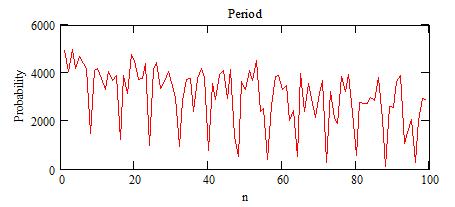
The "probability" is actually the number of acceptable solutions from
the simulation.
Most solutions with n=8 and multiples are eliminated owing to the time-series
of 1 Sep 2009 of AAVSO observers Stephano Padovan (observer code PSD)
and Jim Roe (ROE).
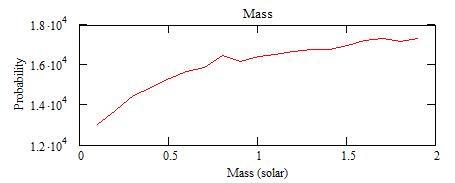
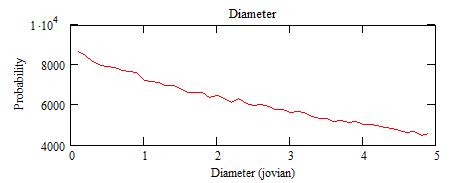
The probability for the eclipse duration:
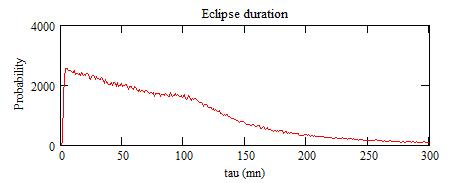
The probability for future eclipses may be computed:
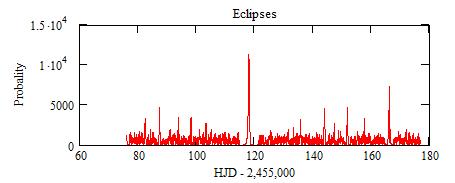
Close-up:
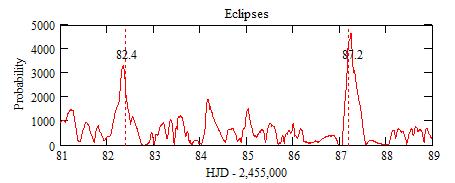
The peak around 82.4 (7 Sep 21hTU) comes from values of n that are multiple
of 19. A time-serie will pick up an eclipse if n=19, 38, etc. or
will eliminate these solutions.
The peak around 87.2 (12 Sep 17hTU) comes from values of n that are
multiple of 11.
The small peak around 84.2 (9 Sept 16hTU) comes from n values multiple of 30.
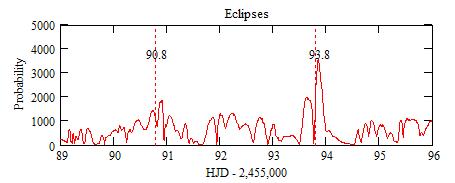
The bump at 90.8 (16 Sep 7hTU) comes from n values multiple of 25 and
the peak around 93.8 (19 Sep 7hTU) from values multiple
of 14.
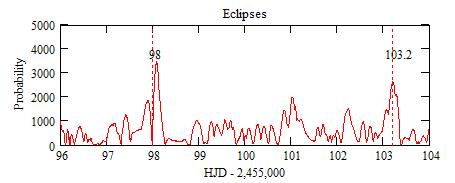
The peak around 98 (23 Sep 12hTU) comes from n values multiple of 17
and the one around 103.2 (28 Sep 16hTU) comes from values multiple of 23.
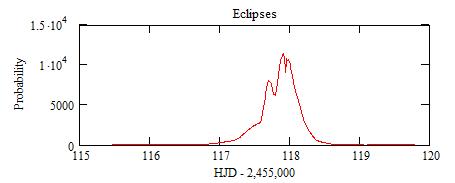
This large peak between 117 and 118.5 (12 Oct 12hTU and 14 Oct 0hTU)
comes from values of n that are multiple of 3.
Discussion
References
Carilli C., Conner S. (1988) IAU Circ. 4648.
Landolt A.U. (1985) IAU Circ. 4125.
Zuckerman B., Becklin E. (1988) IAU Circ. 4652.
|
|
|||
|
|||
|
|
|||
|
|
|||
|
|||
